Gatekeepers used to be everywhere.
Very few people could start a business, publish a book, release a record, or broadcast their opinion without someone else’s financial backing.
Unless you had a particularly wealthy and supportive relative, you’d have to try your luck at the bank or in countless soul-crushing meetings with investors.
And even then, you’d lose large portions of equity or be crippled by high-interest rates.
Thankfully, today there’s another way.
In this article, you’ll learn why crowdfunding for business is so powerful, and essential tips on creating a successful campaign, and some crowdfunding examples sprinkled throughout for inspiration. Plus, you’ll get a rundown on some of the best crowdfunding sites to fund your next venture.
Let’s dive in.
Post Contents



What is Crowdfunding?
Crowdfunding is the process of funding a venture or project by raising small amounts of money from a large number of people.
Crowdfunding for startups is a common practice, and it’s also often used by inventors, entrepreneurs, musicians, filmmakers, artists, and charities.
→ Click Here to Launch Your Online Business with Shopify
It began in 1997 when British rock band Marillion challenged the status quo.
Lacking the money to finance their U.S. tour, the band raised $60,000 from fans – and in the process, created the blueprint for today’s crowdfunding sites.
That’s when the gatekeepers started to lose their stranglehold.
With so few business models you can start without capital, crowdfunding brought opportunity and democracy to funding.1§
Then crowdfunding went mainstream, and online crowdfunding platforms flourished. Suddenly, entrepreneurs and artists could simply ask their fans and customers to fund their new ventures.
Today, most crowdfunding is conducted through crowdfunding sites like Kickstarter or Kiva. Crowdfunders will create a page on one of these sites, where they’ll pitch their project or venture to potential backers.
Then, they’ll attempt to drive traffic to this page using marketing tactics like PR, pay-per-click advertising, and social media marketing.
Let’s look at an example.
Pimax launched a crowdfunding campaign on Kickstarter for “the world’s first 8K VR headset.”
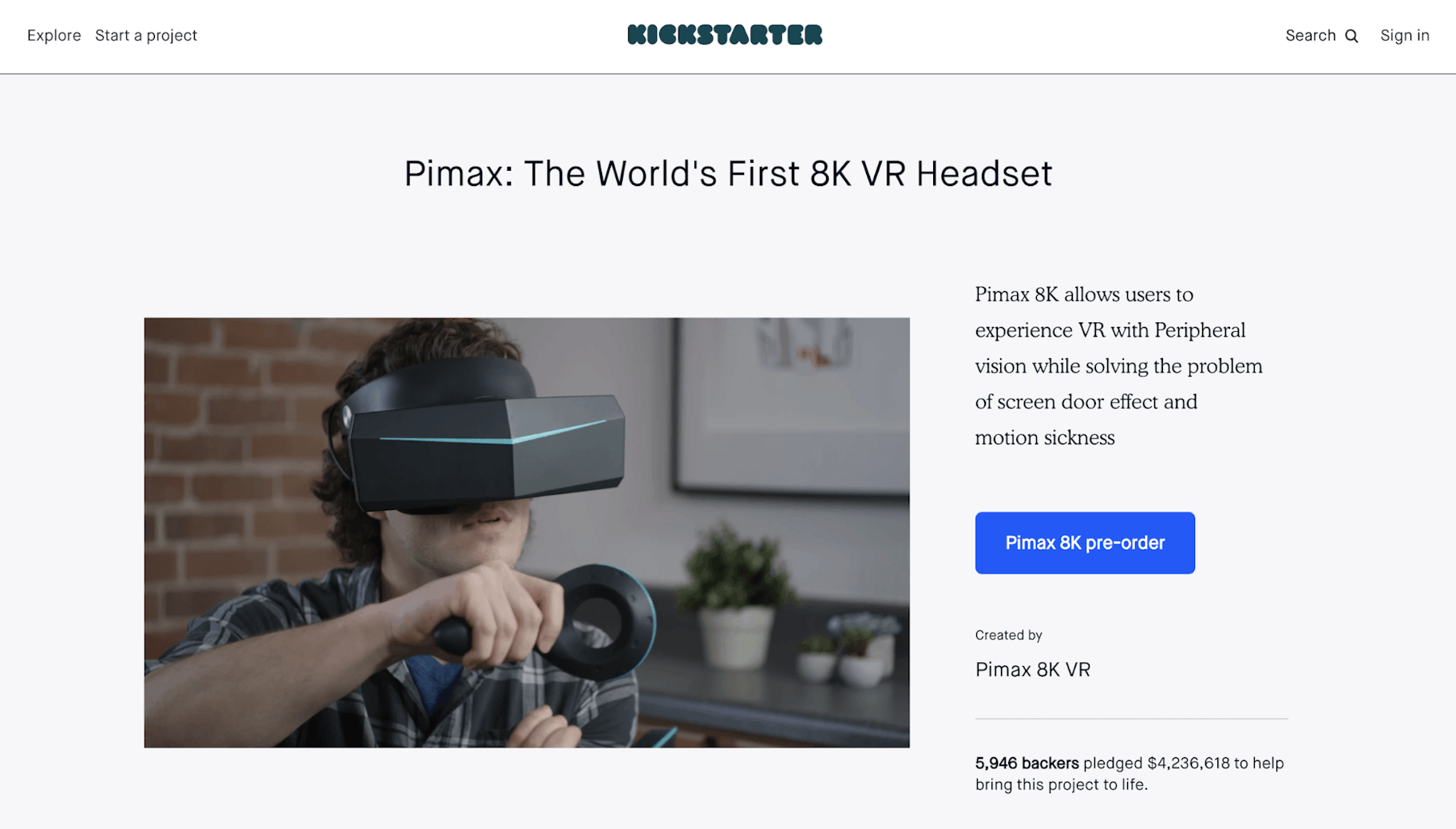
They used the campaign to bring the product to market faster and to improve the product, based on feedback from fans and customers.
After launching, the company raised more than $4.2 million from nearly 6,000 people.
How Does Crowdfunding Work?
There are many types of crowdfunding available. Let’s take a quick look at four of the main ones.
1. Reward-Based Crowdfunding
This is one of the most popular forms of crowdfunding, and it’s synonymous with sites like Indiegogo and Kickstarter.
Reward-based crowdfunding is when people pledge money in exchange for a certain benefit or package.
Take Beeline.
They started a reward-based crowdfunding campaign on Kickstarter to raise money for their new motorbike navigation device.
They provided a tier of rewards in return for different amounts of money, such as:
- $129 or more: One Beeline Moto device, one mount, and a future discount.
- $199 or more: A limited edition machined aluminum Beeline Moto device.
- $229 or more: Two Beeline Moto devices, two mounts, and two copies of the Beeline app.
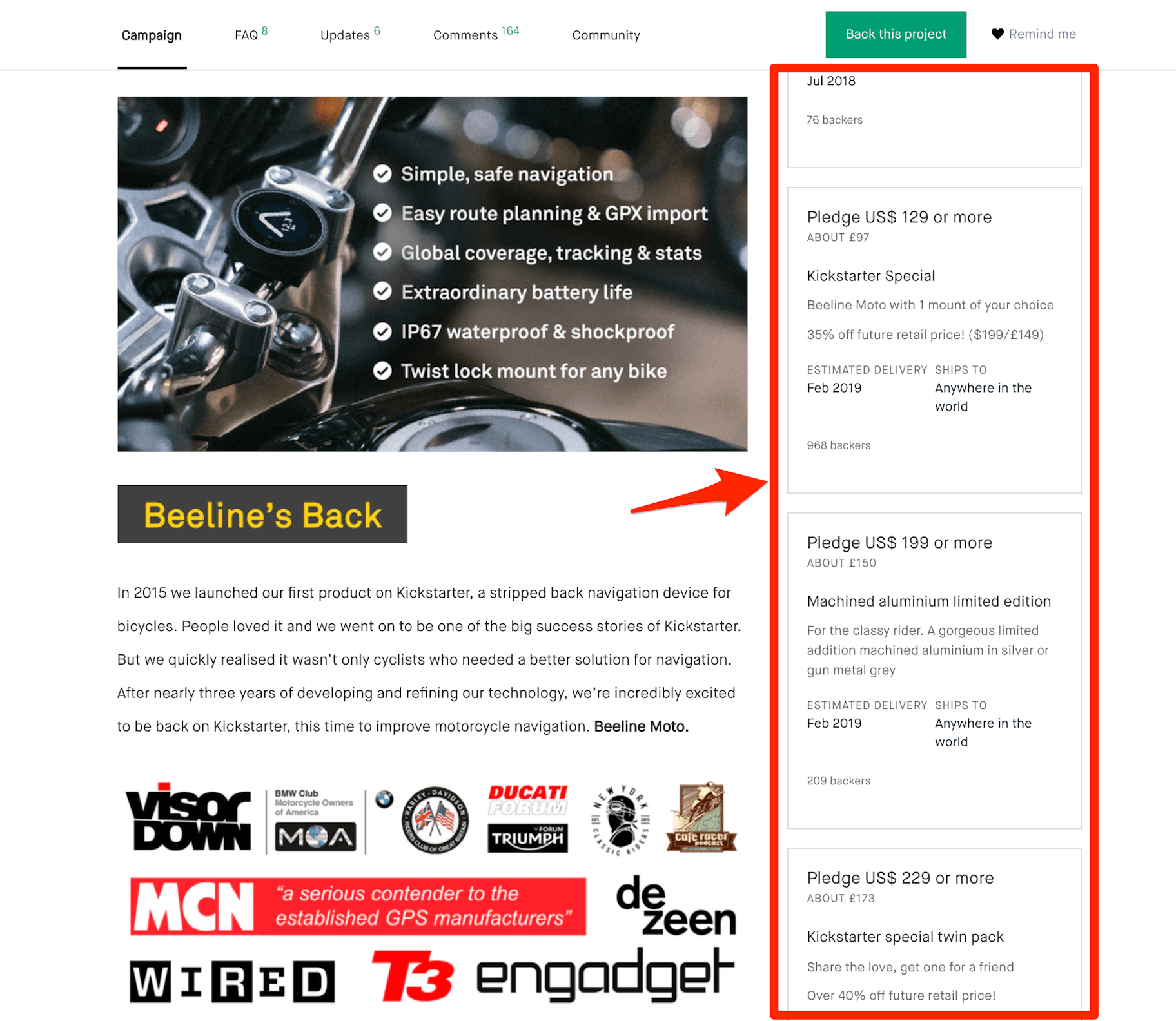
Offering a range of rewards allows crowdfunders to maximize the amount of money they’re able to raise by appealing to all levels of interest.
2. Equity-Based Crowdfunding
This is when an investor receives a portion of the company in return for their investment. Equity-based crowdfunding enables people to become part owners of the project or venture – sharing both the risks and rewards.
The investor can also sell their share of the company in the future.
Crowdfunding sites like Crowdfunder, CircleUp, and OurCrowd allow businesses to partner with their investors.
A great example is Dubuc Motors.
This electric sports car company has used Crowdfunder to raise over $6 million to grow their operations in exchange for equity.
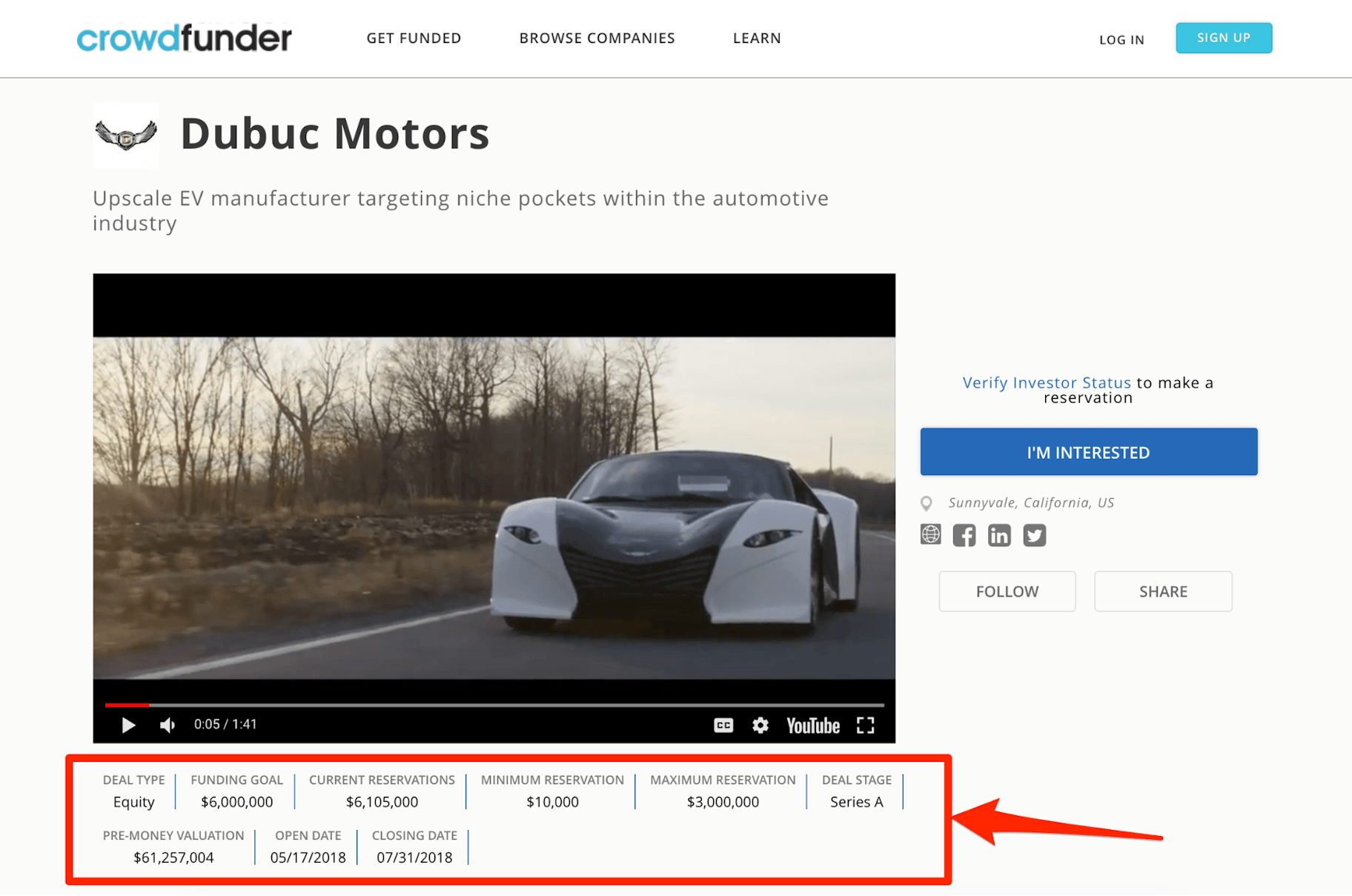
3. Donation-Based Crowdfunding
This form of crowdfunding is when supporters freely donate money without any reward or monetary incentive.
As a result, donation-based crowdfunding is usually employed by charitable causes, such as this campaign on Fundly to support a flood recovery project for the Happy Kids Center:
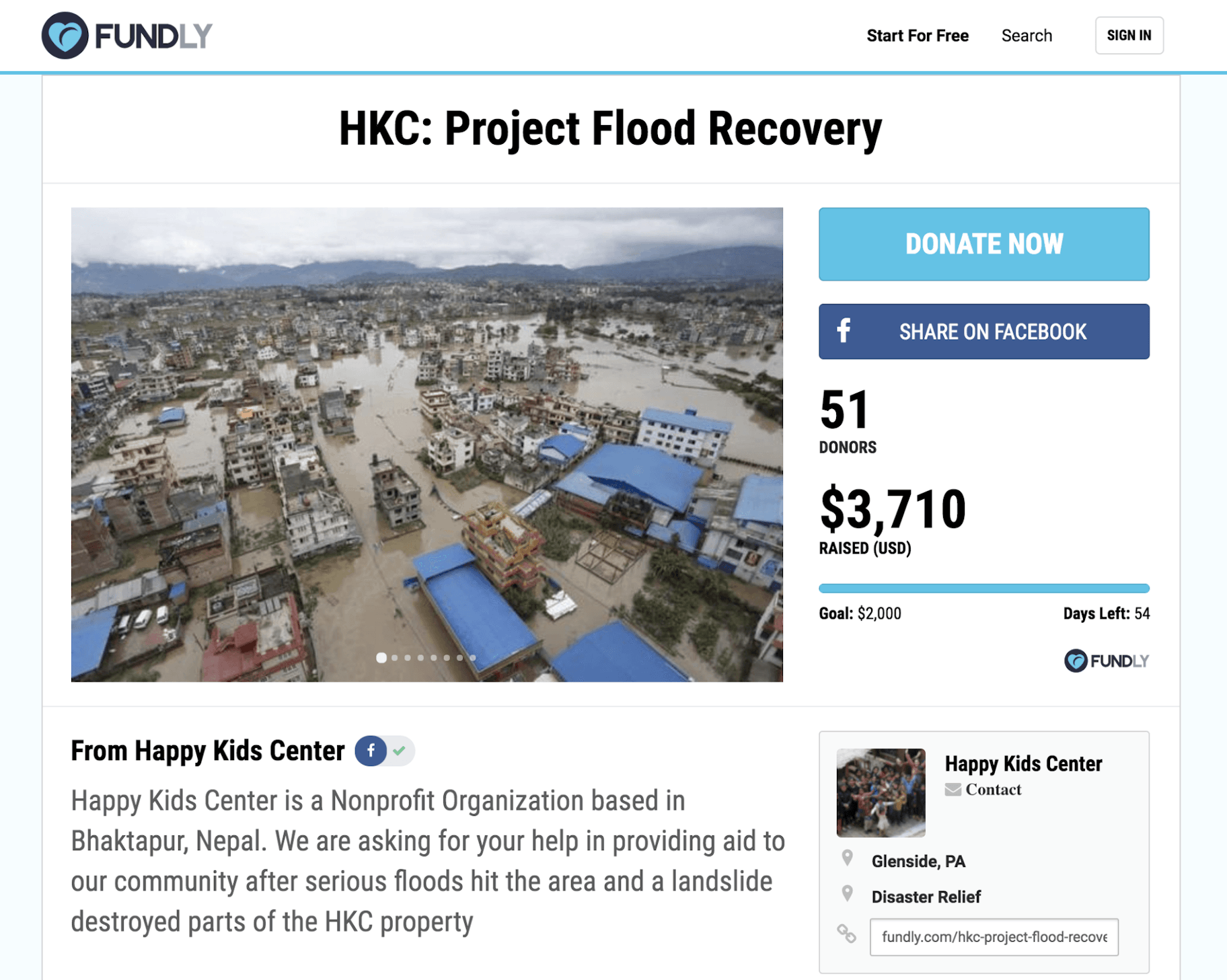
There are many donation-based sites online, such as GoFundMe and JustGiving.
4. Peer-to-Peer Lending
Peer-to-peer crowdfunding sites like Lending Club and Prosper enable people to borrow money outside of traditional bank loans.
It’s great for lenders too.
Those willing to take the risk can easily build a portfolio of loans that often pay higher rates of interest than banks.
Kiva is one of the best known charitable peer-to-peer crowdfunding sites. And it focuses on empowering people to lift themselves out of poverty.
The image below shows Imelda Group’s campaign to raise money to build their local business:
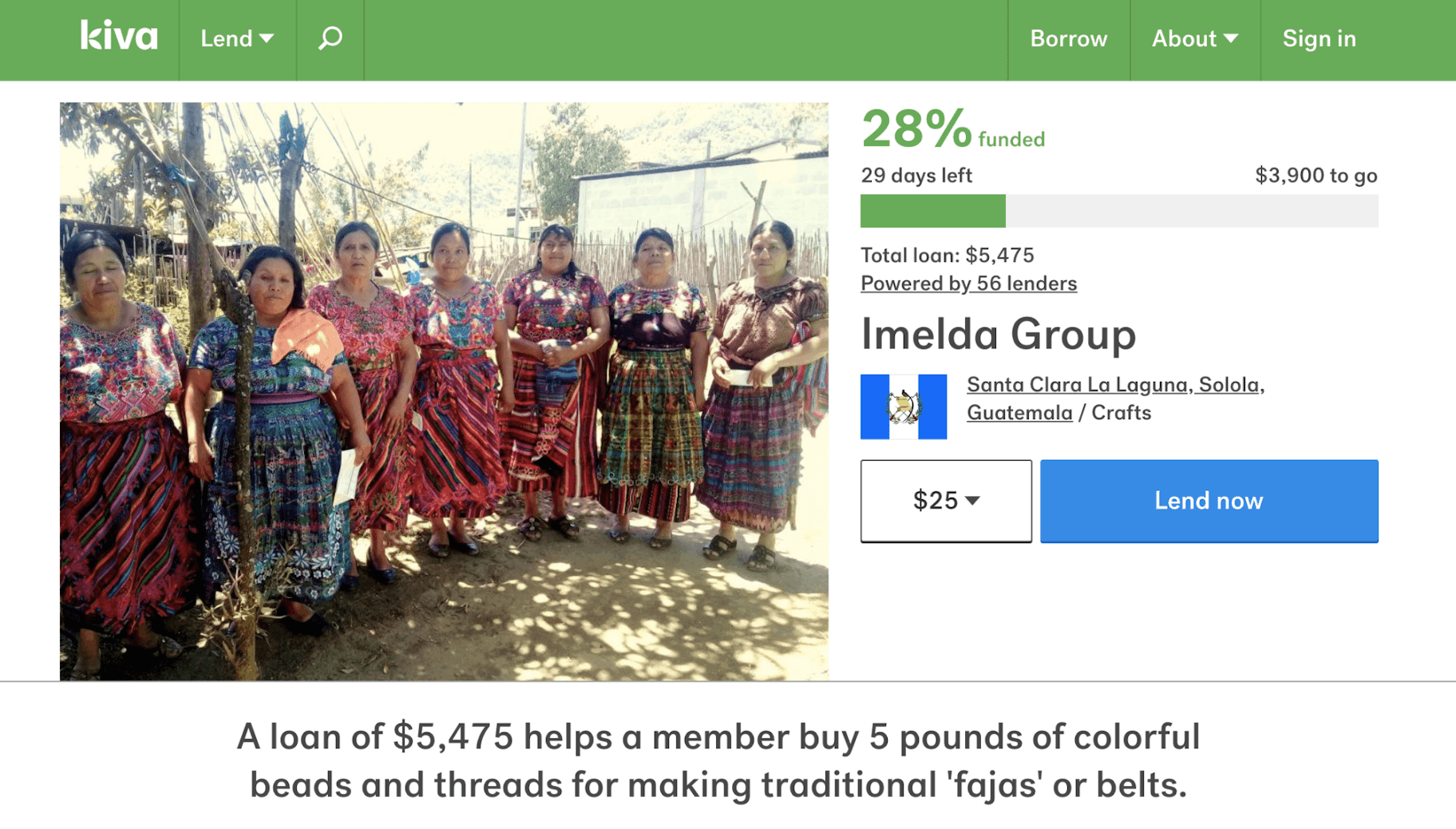
Meanwhile, Lending Club facilitates personal loans of up to $40,000, and investors can choose to invest in individuals or institutions.
Advantages of Crowdfunding
Crowdfunding was valued at $10.2 billion in 2018 globally and this value is projected to reach $28.8 billion by 2025.
So why is crowdfunding so effective? Here are four key advantages:
1. Marketing is Made Easy by Existing Platforms and Engaged Funders
Crowdfunding is rapidly expanding each year.
More and more people are becoming crowdfunders and contributors. However, the best part is that individual campaigns are also taking home larger sums of money.
The image below shows that the average funding per campaign in the crowdfunding arena is expected to rise over the next few years.
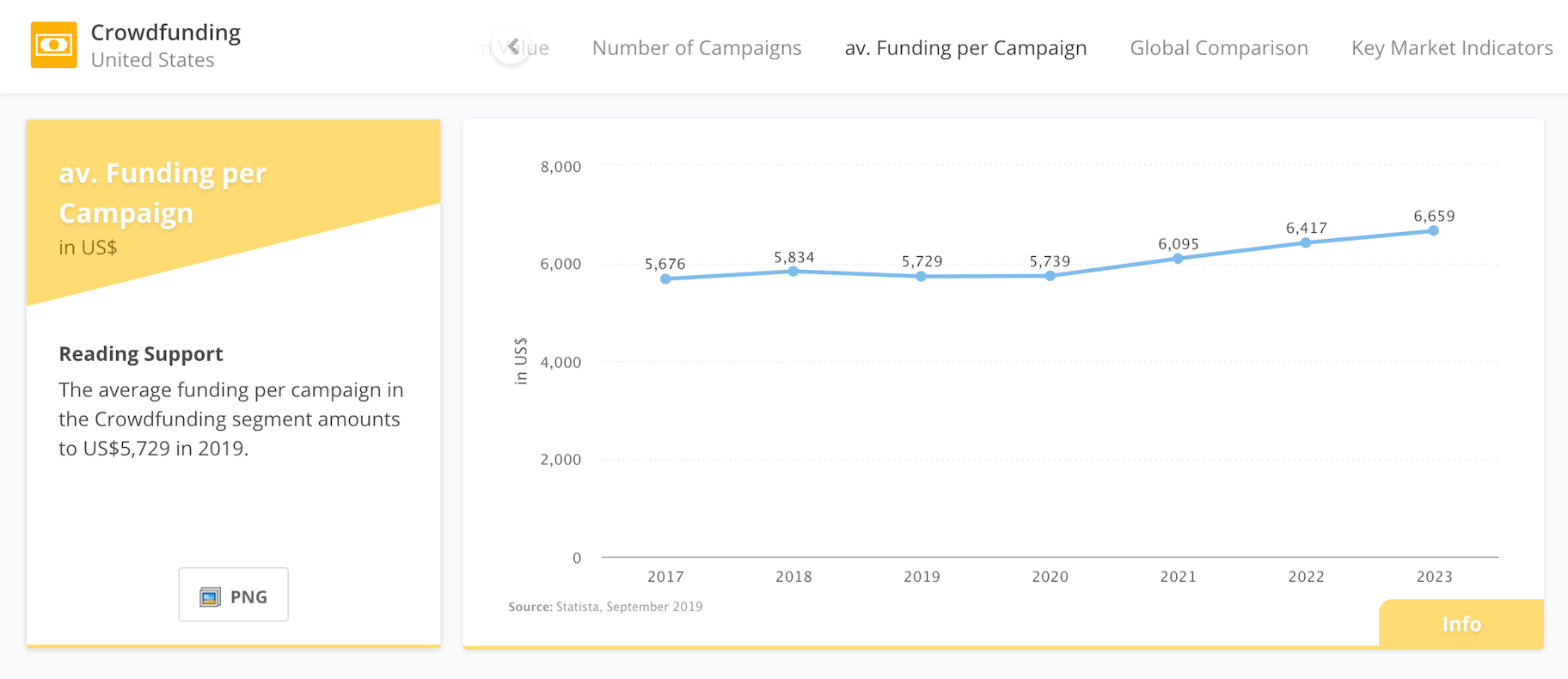
But that’s not all.
Each popular crowdfunding platform has a highly engaged community of investors and customers that are incredibly easy to access.
In fact, according to Alexa.com, Kickstarter and Indiegogo combined receive about 600,000 unique visitors per month.
This is an amazing opportunity.
It means that although crowdfunders still need to drive their own traffic, there’s also a large pool of investors actively looking for projects to support.
In other words, your marketing to warm prospects.
Will Ford, the president and co-founder of LaunchBoom, said, “From our experience running marketing campaigns in a variety of verticals, we’ve found that crowdfunding is the best acquisition channel and results in the best ROI for your advertising dollar.”
What’s more, crowdfunding platforms promote successful campaigns, bringing in new customers at no additional cost.
Ford continues, “Additionally, backers are likely to share your story with their friends on social media, thereby enhancing the virality of the campaign and value of each customer.”
Just check out this passionate post promoting Bravery Co.’s crowdfunding campaign:
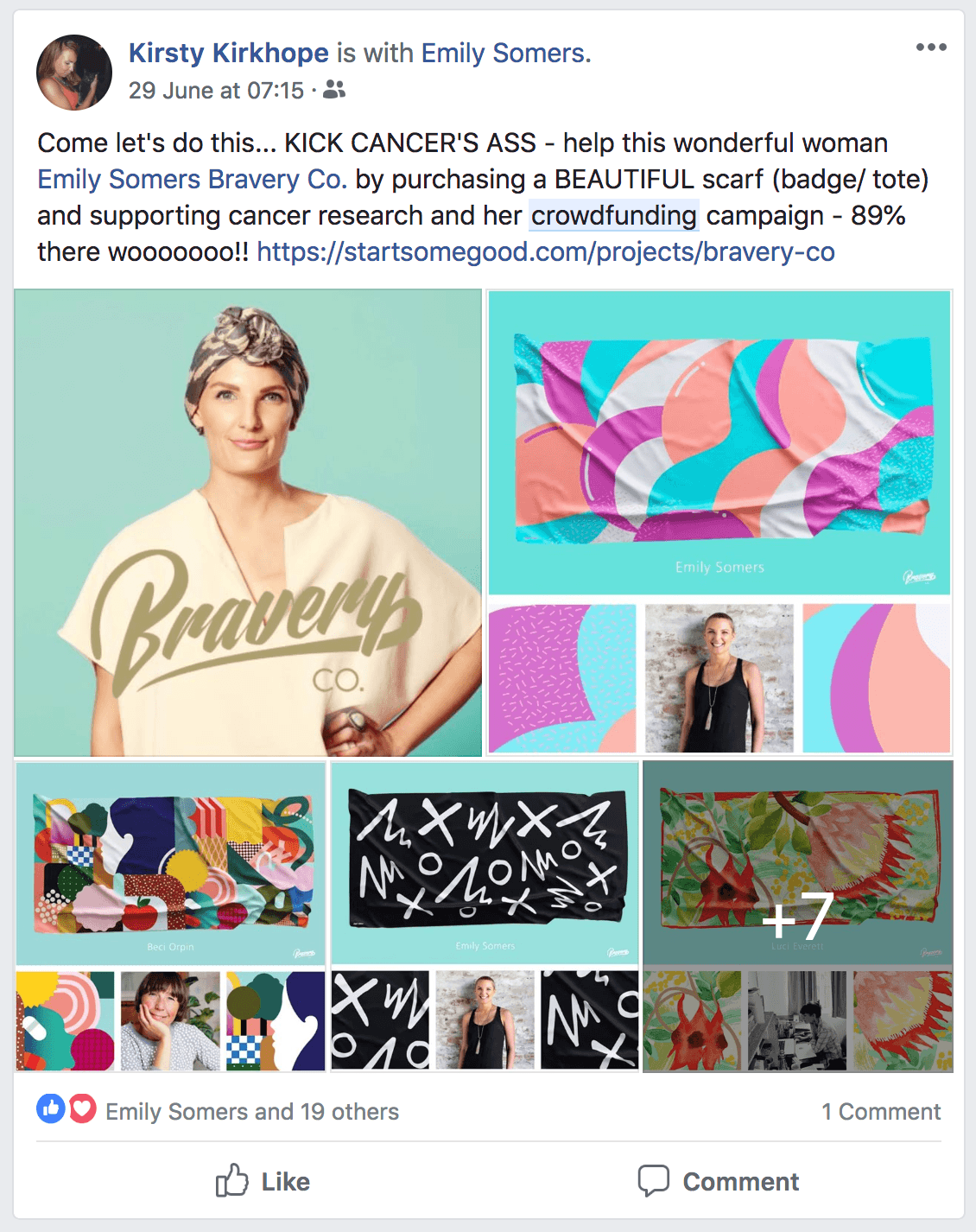
Bottom line: Your marketing budget will stretch further thanks to the free traffic from your backers and the crowdfunding site.
2. You Can Generate More Revenue with Less Risk
Behold the power of pre-sales.
By pre-selling products upfront, you don’t need to buy and store large quantities of stock. As Ford writes, “All you need is a working prototype and a great marketing plan.”
Cash flow problems are greatly reduced and you’ll never order more than you need.
Plus, when you pre-sell thousands of units you can place larger orders with manufacturers. This will nearly always decrease the cost per unit and increase your margins.
In other words, crowdfunding enables businesses to reduce financial risk, and capitalize on economies of scale.
3. You Can Validate Your Product and Use Feedback to Improve it Before Shipping
What is the top reason startups fail?
It’s probably not what you think — it’s not a lack of funding, tough competition, or poor marketing.
According to CB Insights, 42 percent of startups fail due to a lack of market need.
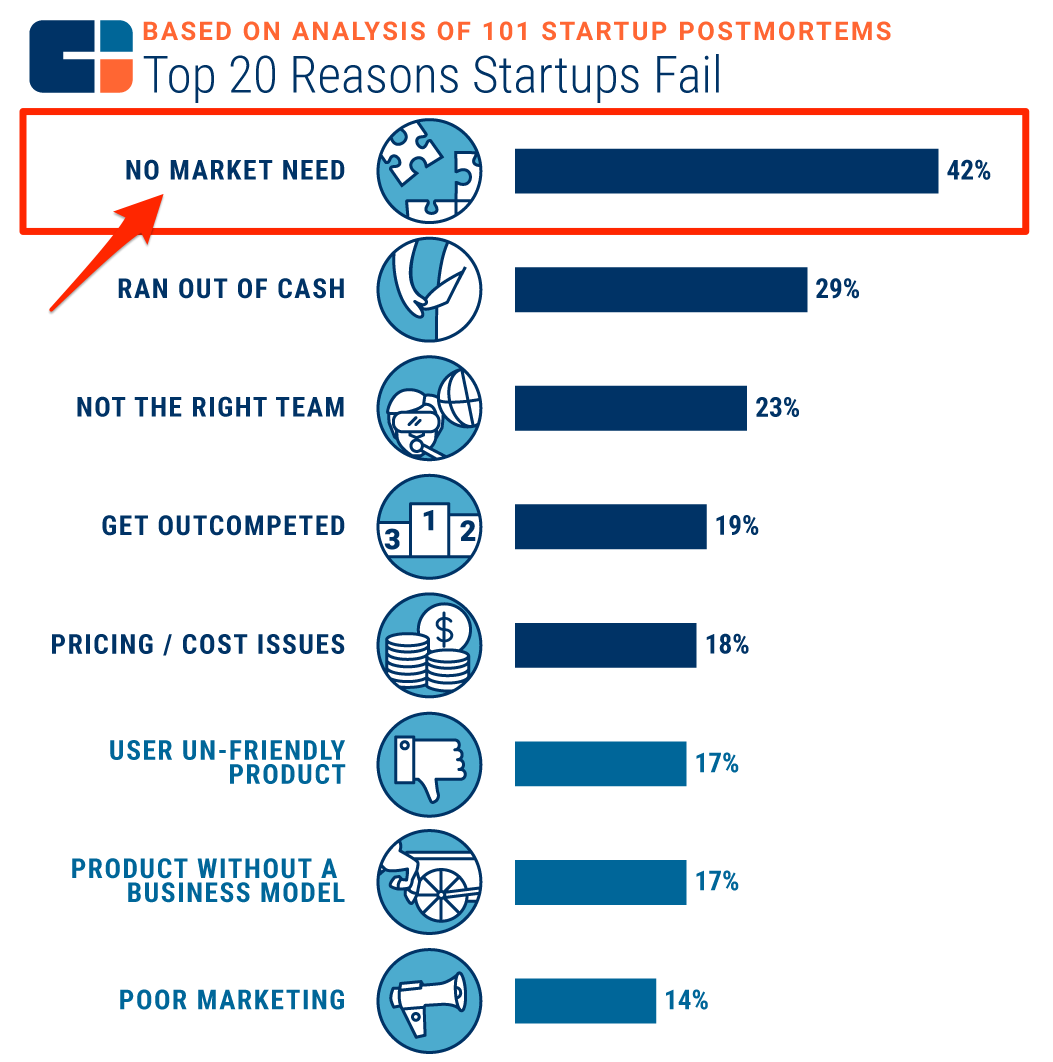
In other words, most startups fail because they build a business that no one needs or cares about.
*Ouch*
Thankfully, crowdfunding solves this problem.
It allows you to validate your idea before you invest in things like manufacturing and operations. Plus, if your idea doesn’t resonate, you can make adjustments or pivot before getting too deep.
But that’s not even the best part.
Crowdfunding also provides a perfect opportunity to improve your product.
Just ask your audience, customers, and investors to share their thoughts. Because they have a vested interest, they’ll tell you what they like, what they don’t, and how to tailor your product to the exact needs of your target market.
Beeline did exactly this when creating their motorbike navigation device.
Philip Marshall, co-founder of We Ride London, said, “Beeline have been excellent at asking what we want and what we need — so [we’re] very excited the new product is coming out.”
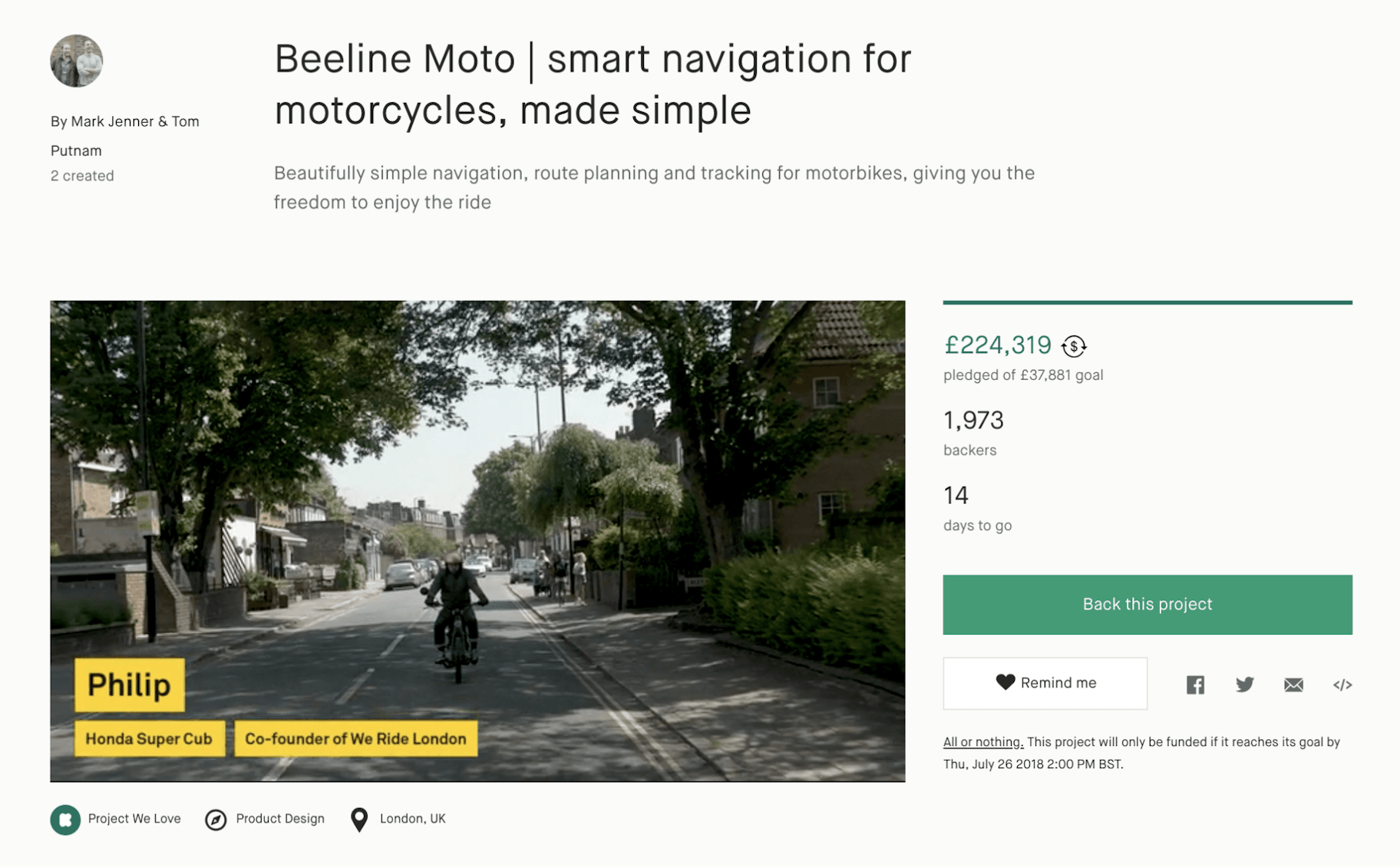
Plus, not only will this strategy hugely improve your business, it will also save you money.
In 2017, businesses spent over $45 billion on market research worldwide. That’s a huge amount of money being spent on figuring out what the market needs.
Viewed alongside crowdfunding, it’s madness.
Why spend billions on market research, when people will give you detailed feedback for free while becoming your most engaged customers?
Cool, right?
4. You can Cross-Sell and Upsell Like Crazy
What are cross-selling and upselling?
- Cross-selling is a sales technique used to persuade customers to purchase additional, complementary products or services. E.g., McDonald’s cross-sells by asking, “Would you like fries with that?”
- Upselling is used to persuade customers to purchase a more expensive upgraded version of the product they’re looking to purchase. E.g., McDonald’s upsells by asking, “Would you like to supersize your order?“
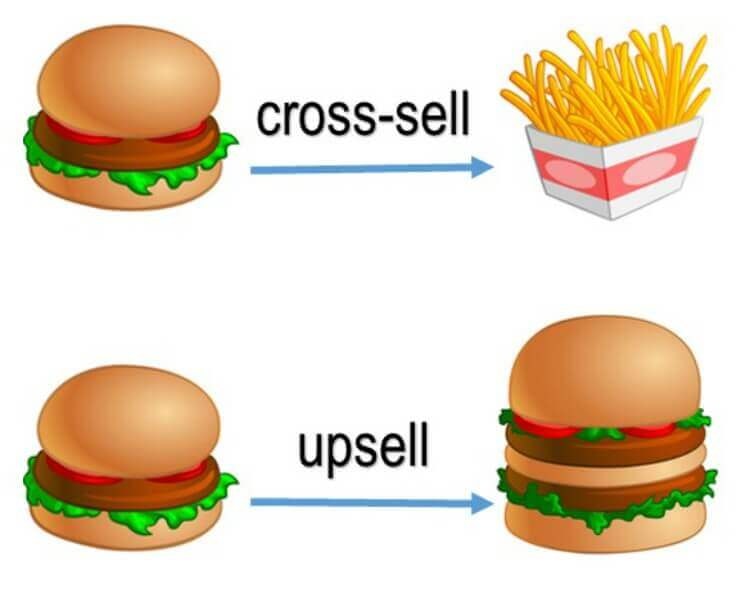
Rewards-based crowdfunding provides an incredible opportunity to increase revenue by selling upgrades, extras, and package deals.
What’s more, this opportunity doesn’t end when your campaign finishes.
Then you can reach out to your customers and offer add-ons, accessories, or new product lines.
Plus, your first campaign can often act as rocket fuel for the second crowdfunding campaign.
Adam Poots, the creator of fantasy board game Kingdom Death, has launched four Kickstarter campaigns to date. The first of which raised just $1,741 to produce an elaborately sculpted collectible figurine.
Then Poots turned his attention to extending the figurines into a board game.
His launched his third Kickstarter campaign in November 2012 for the board game “Kingdom Death: Monster,” and raised more than $2 million.
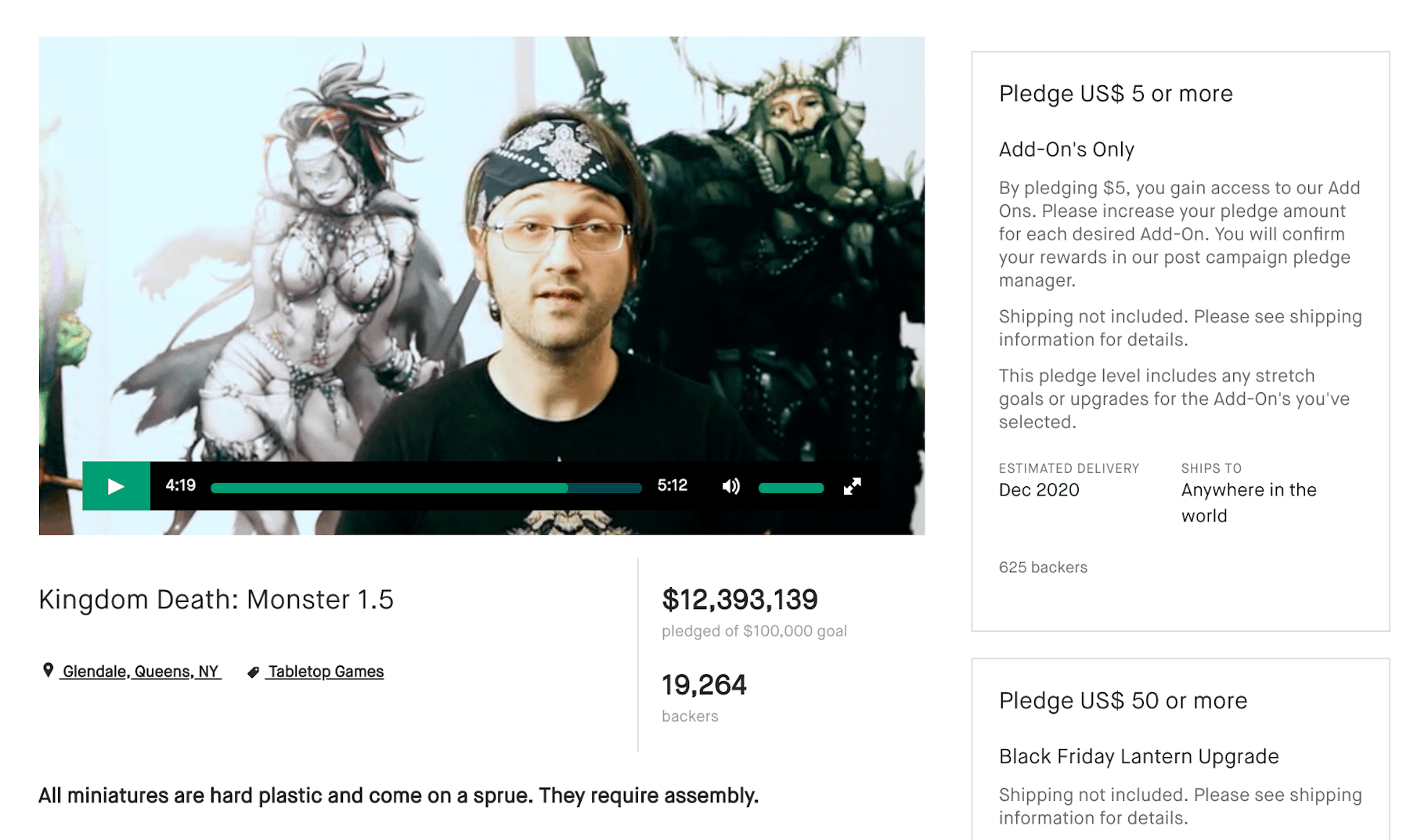
In 2016, Poots returned to Kickstarter to reprint the game with new content.
By leveraging the audience and momentum he’d built, “Kingdom Death: Monster 1.5” raised a massive $12.4 million – $4 million in the first hour alone.In summary: You can upsell and cross-sell within campaigns, and to the audience you’ve built when you launch future campaigns.
Okay, next up:
3 of the Best Crowdfunding Sites
There are hundreds of crowdfunding sites out there – in fact, there are more than 375 crowdfunding platforms in North America.
So here’s a quick round-up of three incredible reward-based crowdfunding sites to fund your next venture:
Crowdfunding Site #1: Kickstarter
Summary: All-or-nothing crowdfunding.
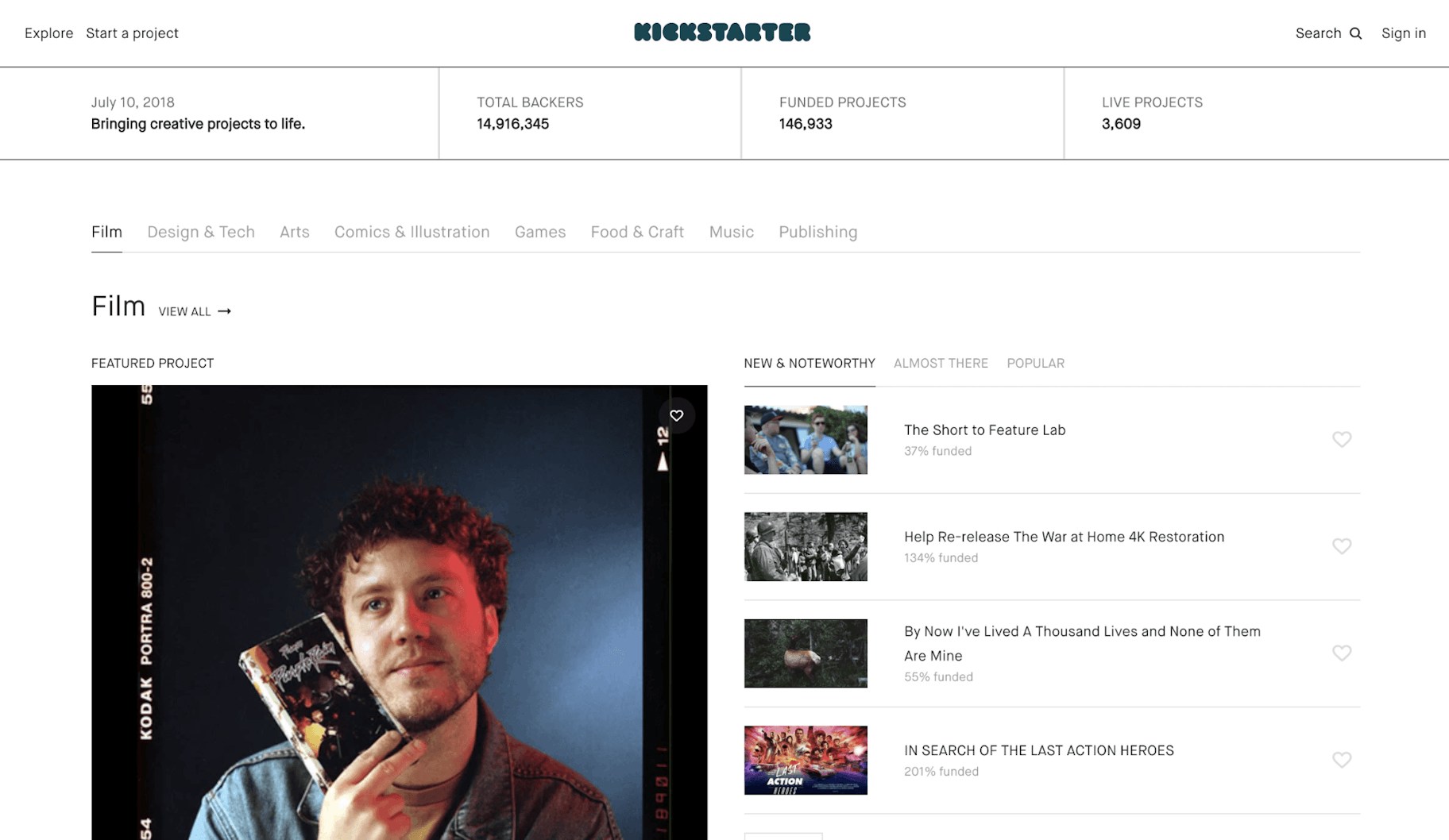
Kickstarter is one of the best-known mainstream crowdfunding sites.
For this reason, crowdfunders are able to capitalize on Kickstarter’s existing audience and brand.
The site hosted the largest crowdfunding campaign of all time: The Pebble Time Smartwatch (since acquired by Fitbit). This campaign launched in 2015 and raised more than $20.3 million from over 78,000 people.
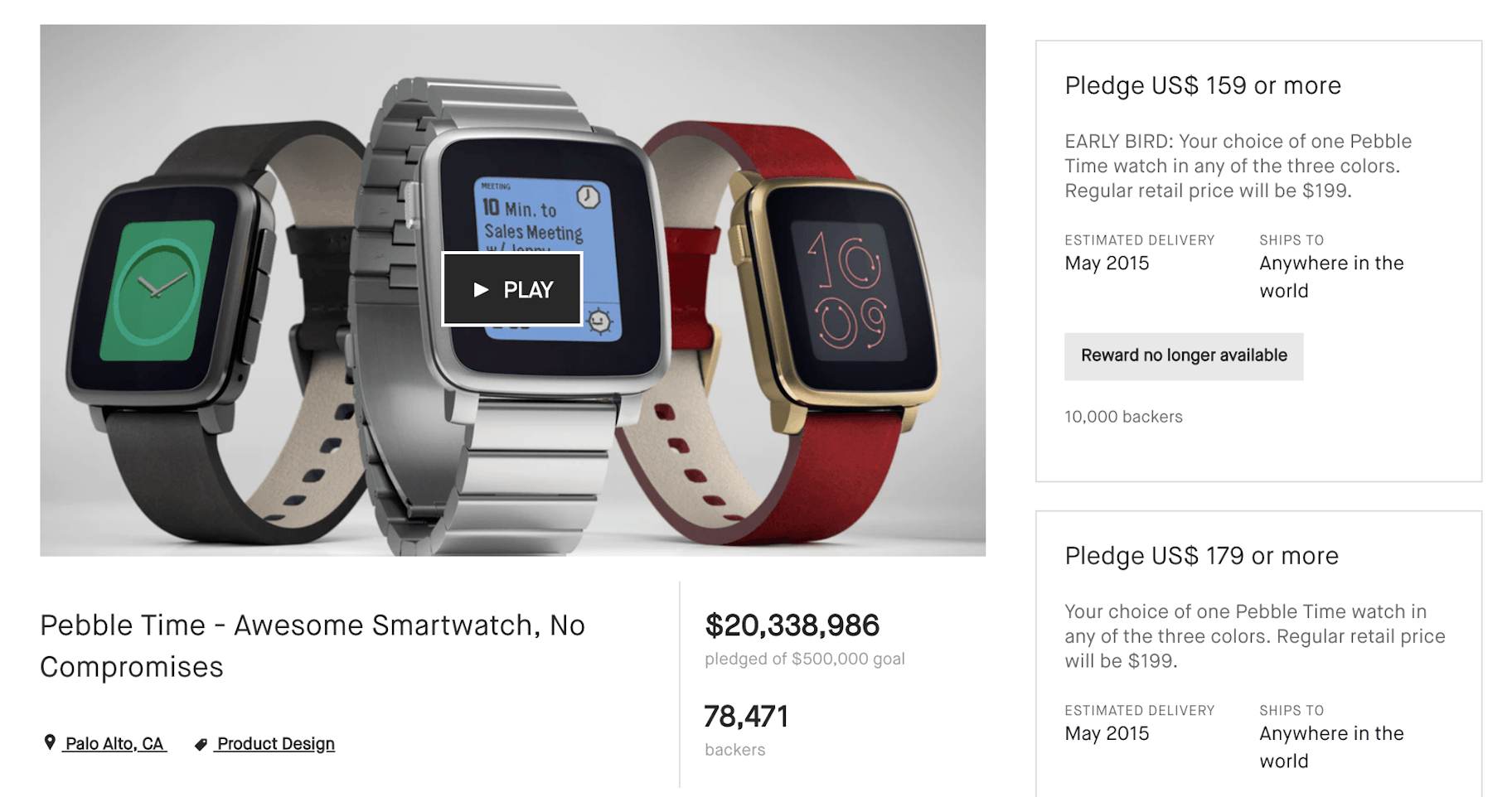
You can use Kickstarter to set a financial goal, and a deadline to raise the money by. Then, you can offer different rewards at different price points.
Kickstarter’s core tenet is an “all-or-nothing” system. This means that funders aren’t charged unless the campaign meets its goal.
The site maintains that all-or-nothing funding is less risk for everyone, saying, “If a project doesn’t reach its funding goal, creators will not be expected to complete their project without the funds necessary to do so, and backers will not be charged.”
This system also breeds motivation and urgency.
Kickstarter says, “We find that projects either realize and surpass their goal, or they never fully take off.”
Crowdfunders are limited to creative projects and must be approved before they can begin campaigning. The site charges 5 percent of funds raised, plus 3–5 percent transaction fees.
Crowdfunding Site #2: Indiegogo
Summary: Flexible rewards-based crowdfunding.
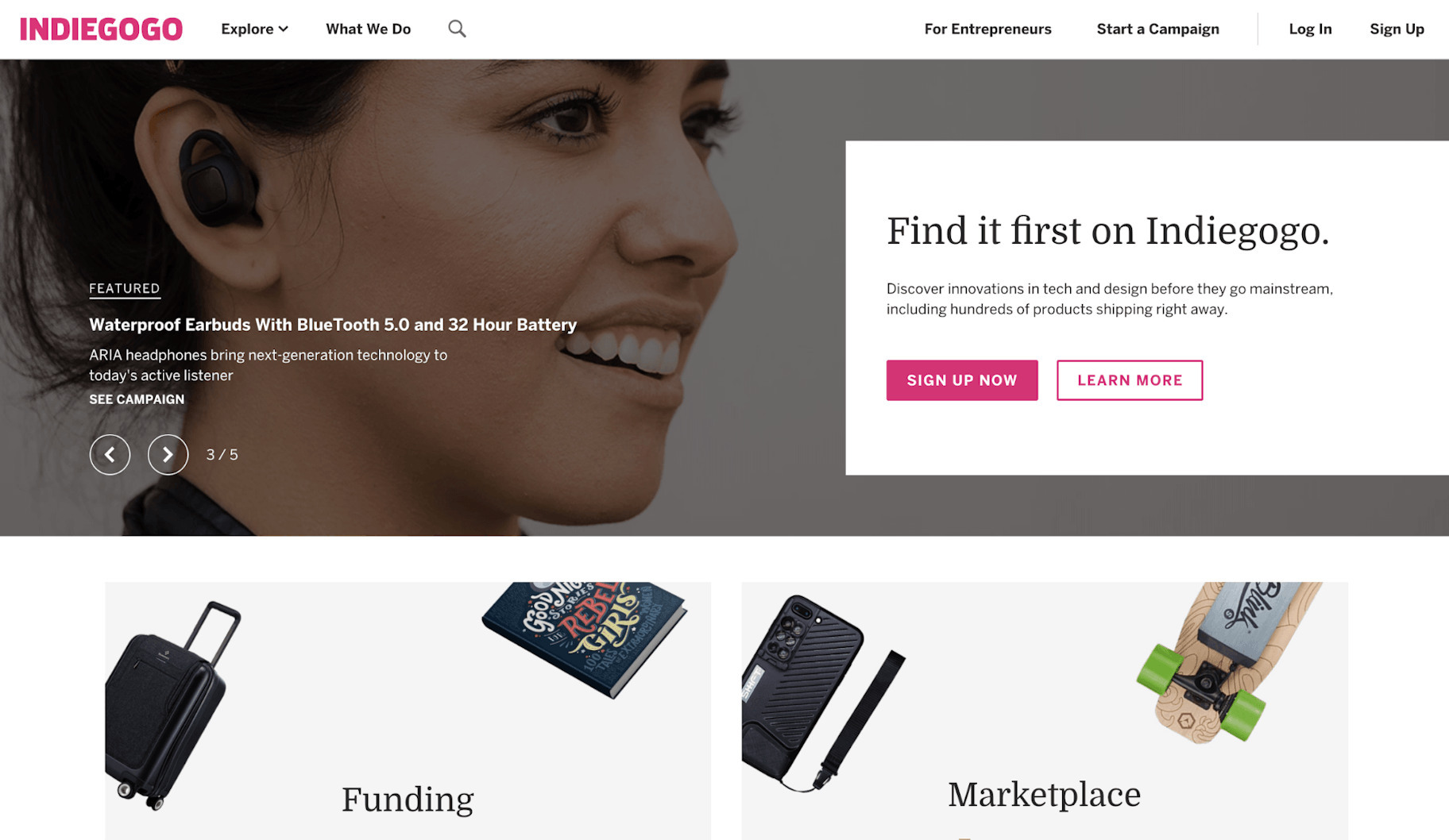
This site has hosted it’s fair share of hugely successful crowdfunding campaigns too, such as The Flow Hive. This father and son team launched a campaign in 2015 for their innovative new beehive, raising more than $14.9 million from over 40,000 people.
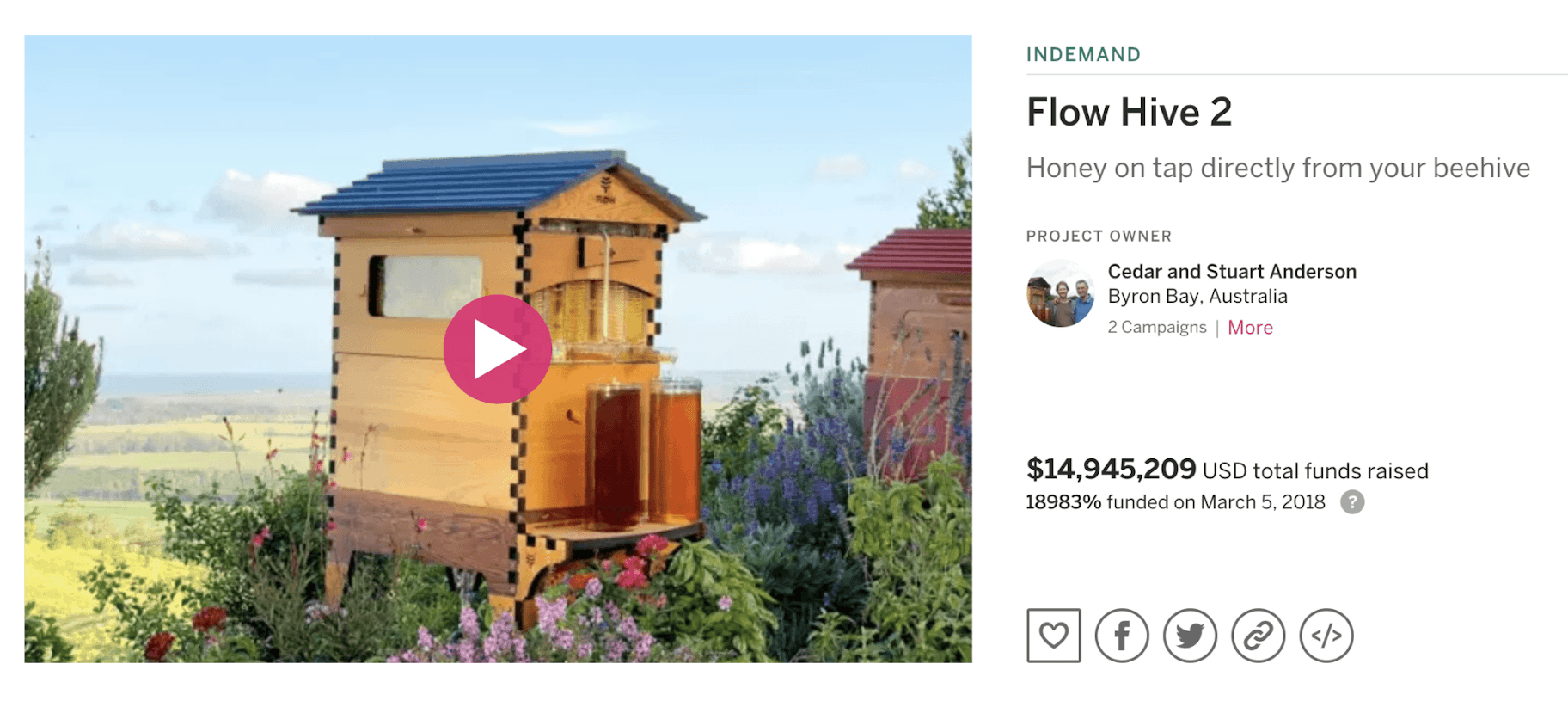
With this option, you get to keep all funds, even if you don’t meet your goal. This is a fantastic option if any amount of money will allow you to implement your campaign objective and fulfill funder’s rewards.
However, if you have a strict go/no-go threshold, you can still opt for fixed-funding.
What’s more, unlike Kickstarter, Indiegogo doesn’t require you to pass an application process. The site charges 5 percent of campaign funds, and transaction fees are an additional 3 percent + 30¢.
Crowdfunding Site #3: Patreon
Summary: Ongoing crowdfunding for creators.
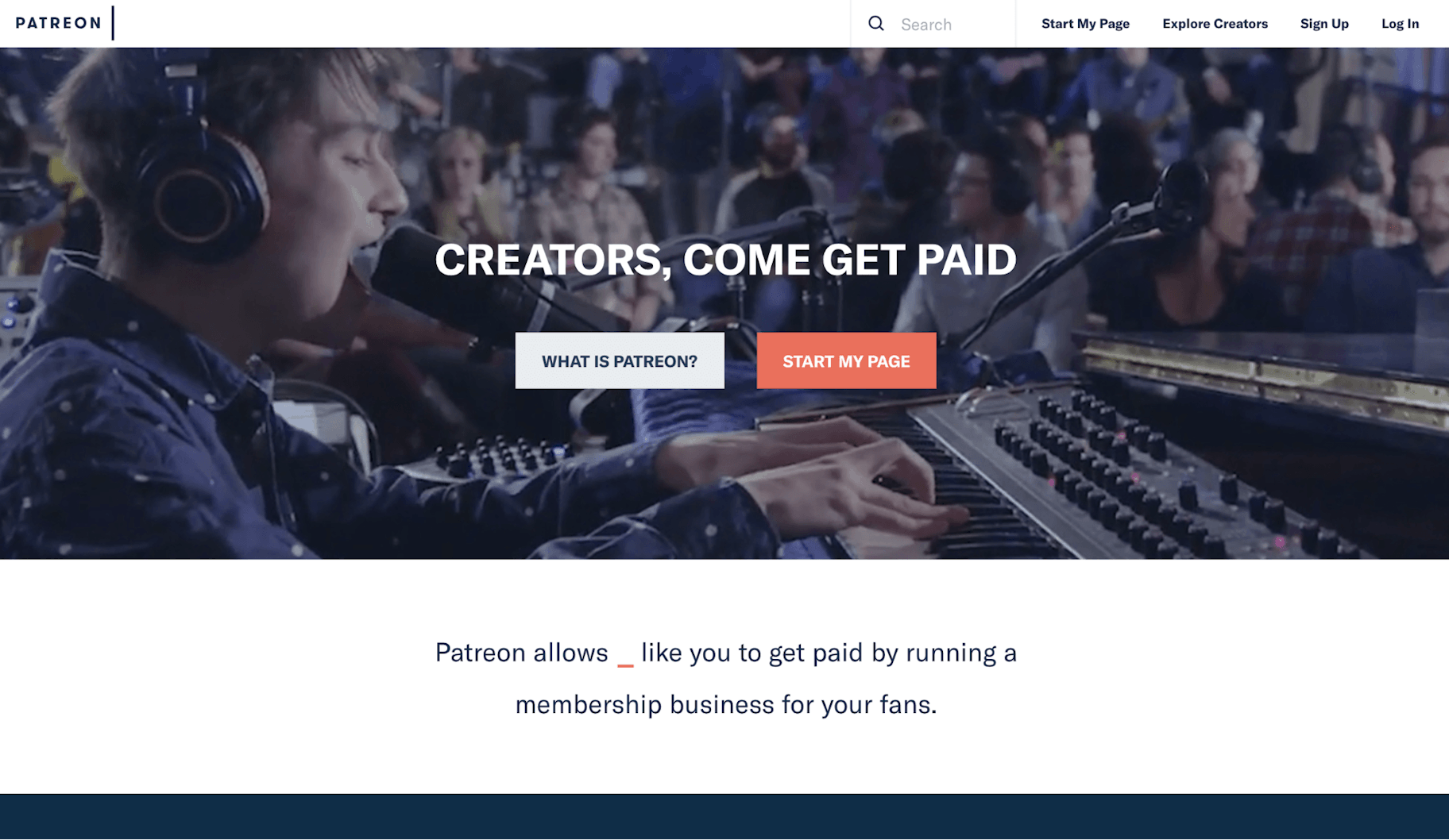
Patreon is different from most crowdfunding sites. It’s primarily used by creators who want to crowdfund on an ongoing basis.
As a result, the platform is used by many musicians, YouTubers, podcasters, and filmmakers.
One of the most successful users of the platform is the Chapo Trap House podcast, with more than 22,000 patrons, contributing over $101,000 per month.
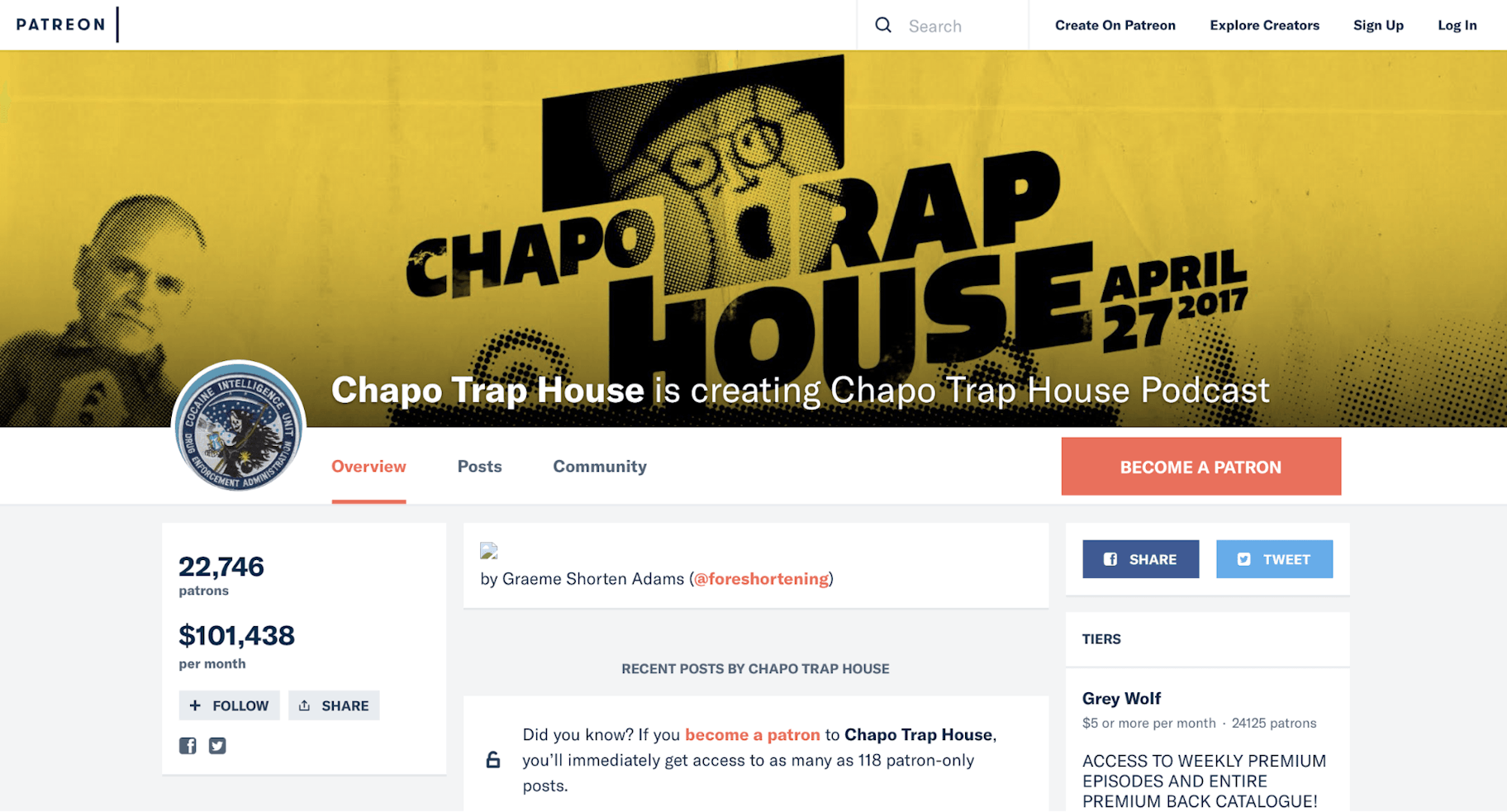
Fans can sign up at different reward levels, contributing whenever the creator delivers new content. Patreon then charges contributors at the end of each month.
The site isn’t geared up for your typical startup launch, but for any ongoing projects, it’s heaven-sent.
Patreon’s subscription-based model means that success depends less on massive exposure and buzz. Instead, strong relationships with fans and building a loyal audience are key.
Which Crowdfunding Site is the Best?
It really boils down to your specific situation: your product, your target audience, your offerings for investors, and your crowdfunding goals.
Kickstarter is great for introducing your idea to a large audience, but you only get the funds if you reach your campaign goal. Indiegogo also has a built-in audience, though it’s more flexible and doesn’t require fully funded campaigns to disperse funding. Patreon is a great option for artists and other creatives selling their wares and ideas.
How to Start Crowdfunding: 6 Essential Tips
Regrettably, only 50 percent of crowdfunding campaigns are successful.
However, many far surpass their original expectations. For example, Flow Hive has raised almost $15 million with an original goal of just $70,000!
Here are six essential tips to crowdfund your way to success:
1. Create Something Truly Unique and Highly Valuable
In order to capture people’s attention – and money – you have to produce real value.
This is almost certainly the most difficult part of the process, but without it, you’re doomed from the start.
Cedar and Stuart Anderson spent almost a decade tinkering in their shed to create their innovative Flow Hive. However, what they’ve created has revolutionized an entire industry and culture.

Andrew Beltran, co-founder of Original Grain, says that “you have to stay focused on the core product and what you’re trying to bring to market.”
2. Prepare Everything in Advance
Paul Farago, a veteran crowdfunder and the founder of Ace Marks, says, “A Kickstarter campaign isn’t something you can just do, you must spend a lot of time planning.”
You need to be able to give detailed answers to questions like:
- What is the core benefit your product provides?
- Why is that core benefit so important?
- Who are your target market and target audience?
- Who are your main competitors, and what makes you different?
- How much money do you need to raise?
- What will that money be spent on specifically?
- Which form of crowdfunding are you going to use?
- What happens if you don’t meet your target?
- How much money do you have for marketing activities?
- Which marketing channels are you going to focus on?
Chris Hawker, a crowdfunding expert and the CEO of Trident Design, said, “It is the work we do before the campaign actually begins that sets us up to win and creates the success.”
3. Build a Crowd Before you Launch Your Crowdfunding Campaign
Khierstyn Ross, the founder of Crowdfunding Uncut, says, “If you launch your campaign with zero audience you are launching to crickets.”
The most successful crowdfunding campaigns build an audience first. This is how Flow Hive hit their original goal of $70,000 in just 8 minutes after launching.
In fact, campaigns that raise 30 percent of their goal within the first week are more likely to succeed.

Chris Muscarella, a crowdfunder and founder of Field Company, says, “The first step is to soft-sell your concept months in advance of your Kickstarter.”
So utilize your existing networks, start blogging, and get involved in your niche community. Do whatever you need to get your campaign off to a good start.
4.Make Sure Your Product is Right for Crowdfunding
Not every product idea is crowdfunding-worthy.
There’s a reason crowdfunding campaigns go viral: They’re newsworthy, unique, and innovative. If your product is too similar to other offerings already on the market, no one is going to feel compelled to contribute to it.
Your first step? Market research. You need to be sure that your idea hasn’t been executed before and that there’s a need for your product.
If you’ve checked that box, check out trending products on crowdfunding platforms. What commonalities do you see? Why are these campaigns trending?
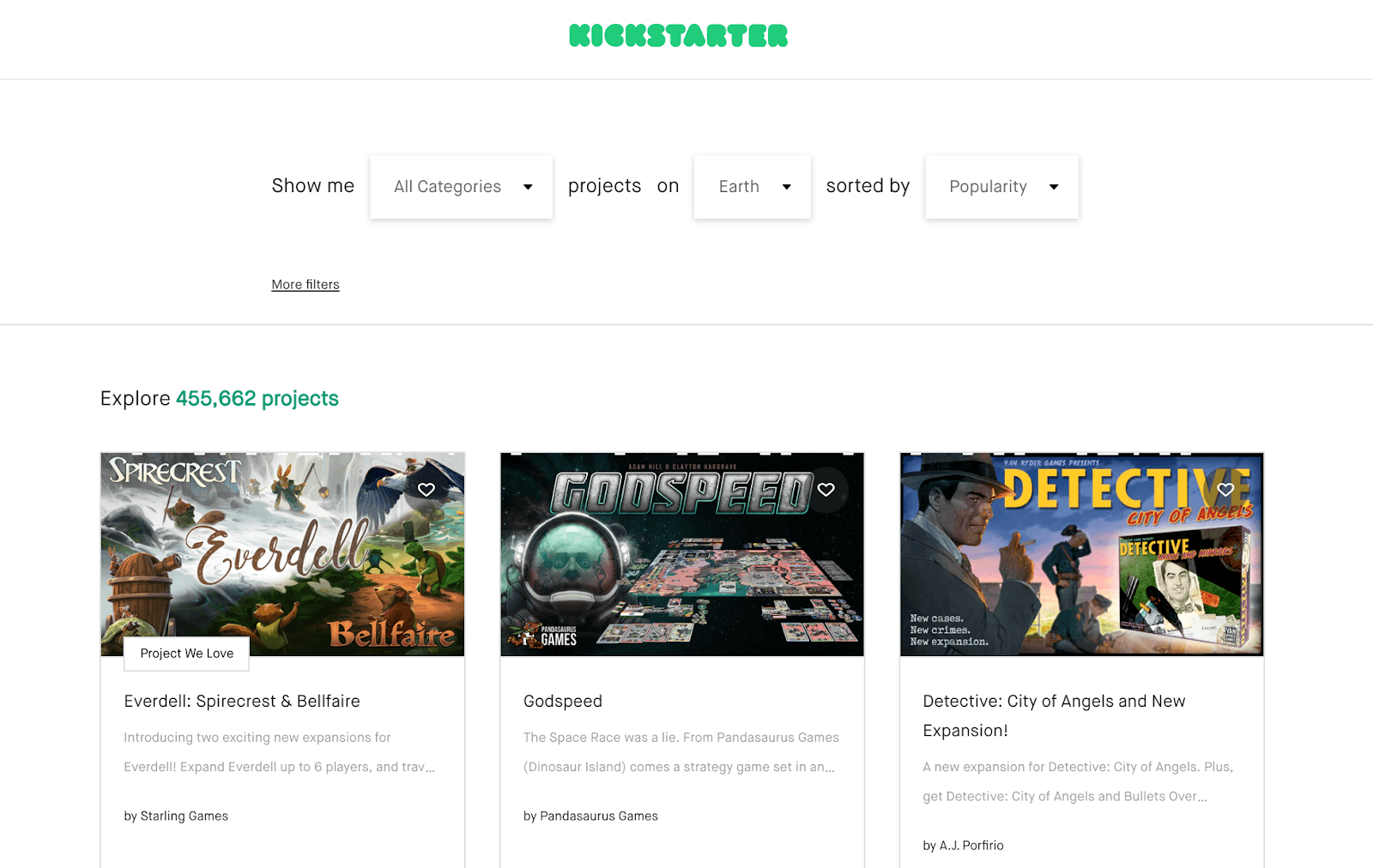
5. Create Compelling Content
Notice how video is a component to almost every successful crowdfunding campaign? That’s because video is an effective marketing tool. Cisco reports that 82 percent of all consumer internet traffic will be video by 2021.
But you need more than just a stellar video to build buzz and create sustainable traction, ultimately leading to a fully funded campaign.
Your crowdfunding campaign content checklist should include:
- At least one hero video pitch
- Beautiful, professional-quality product photos and renderings
- Catchy headlines and copy
- Press kit
- Social media
6. Offer Motivating Pricing Tiers that People Actually Want
Part of the fun behind investing in crowdfunded projects is the rewards you earn for being a supporter early on. Sometimes it’s as straightforward as a discount on the product. KOALA Super-Grip Phone Harness incentivizes commitment by promising a larger percentage discount for larger orders.
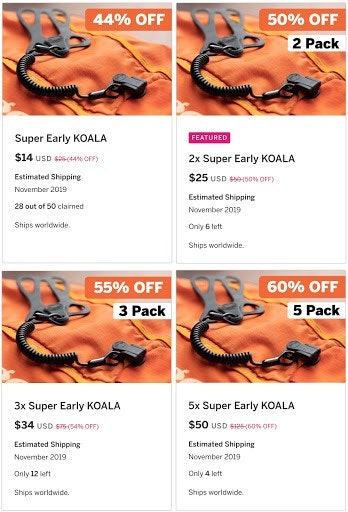
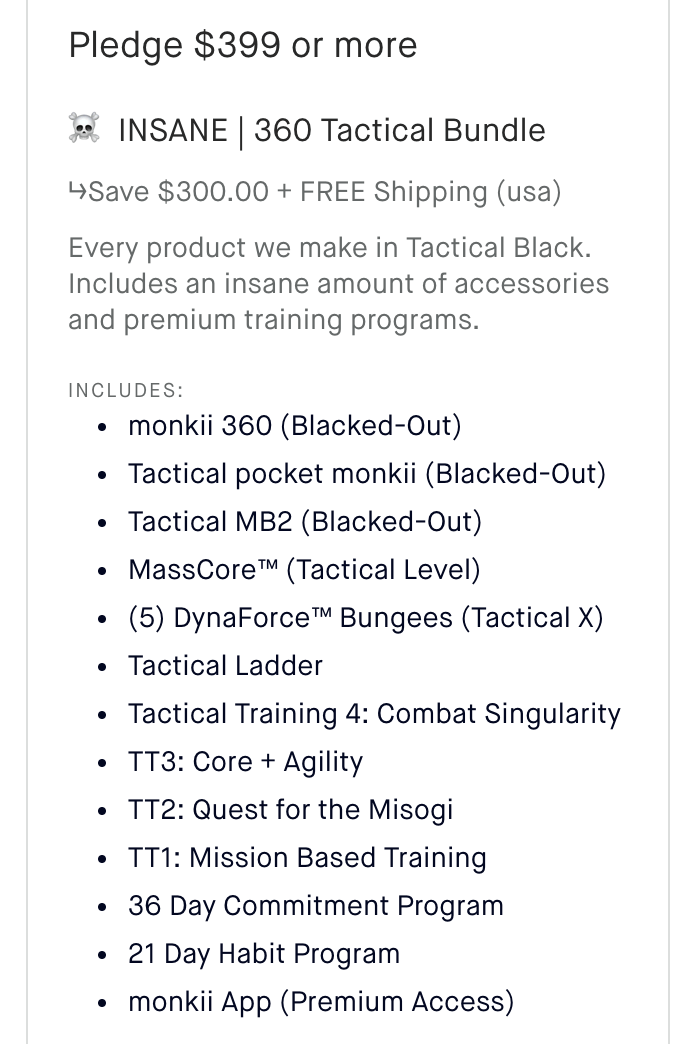
No additional products to offer? Think of other bonuses: Maybe they get early-bird shipping or access to a complementary online platform, or maybe they get a chance to go behind-the-scenes with the people behind the product. If you need more ideas, Kickstarter has a list of 96 rewards to consider.
Crowdfunding Best Practices
Tell a Great Story and Be Transparent
Great stories capture hearts.
Clay Hebert, the founder of Crowdfunding Hacks, says, “The best campaigns I’ve worked with tell a specific story to a specific group of people.”
This is why campaigns with personal videos raise 105 percent more than those that don’t.
So find ways to engage with your audience. Create a touching video, share plenty of photos, and let your business’s personality and values shine through.
Nikolaj Hviid, a crowdfunder and the founder of Bragi, says, “Convey the magic of your project and why you are determined to deliver what you have promised.”
Clearly Communicate What Funders Stand to Gain
No one’s going to give you money for nothing.
Even with donation-based crowdfunding, contributors receive a sense of satisfaction and goodwill when they help a good cause.
You need to constantly ask, “What’s in it for them?”
As Thomas Dadourian, CEO of LaunchBoom, said: “Backers on Kickstarter and Indiegogo want cool stuff, at a discount, before anyone else.”
So create your reward tiers carefully and offer early-bird incentives.
And always provide more value than the cost you charge. If you go above and beyond for your funders, they’ll be more likely to support you in future campaigns.
Don’t Stop Campaigning
Even when you’re fully funded, it’s important to keep the momentum going. Remember the long-term goals here: You want to develop a devout customer following who will support you now and post-campaign.
You’ve spent all that time building an email list, so you’ll want to continue to use it.
Keep people updated on the development of your product. Share behind-the-scenes content from manufacturing or marketing asset development, ask investors to provide input on product design features, and keep the excitement going.
Summary: Moving Forward With Your Crowdfunding Ideas
Crowdfunding is an incredible opportunity.
This cultural phenomenon has democratized funding and eradicated gatekeepers. Now, anyone with a great idea and the ability to execute it can raise the funds needed to succeed.
Have you ever taken part in a crowdfunding campaign? Let us know in the comments below!






